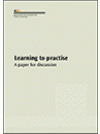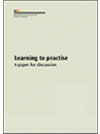Learning to Practise is a companion paper to Initial teacher education outcomes: Standards for graduating teachers (Aitken, Sinnema, & Meyer, 2013). Its purpose is to describe and exemplify the design of practice-based experiences that will promote the outcomes identified in the first paper.
There are two urgent reasons for reviewing how we do initial teacher education. The first is the disparity in achievement outcomes evident in the performance of New Zealand students in national and international assessment studies; the second is the disconnect between what we now know about effective teaching practice and what actually happens in the classroom. Underscoring this latter issue, a recent OECD report (Jensen, Sandoval-Hernandez, Knoll, & Gonzalez, 2008) found that “structured teaching experiences” (transmission teaching) “were used more frequently by new teachers than student-oriented and activity enhanced teaching practices that we know to be more effective. There were few differences between new and more experienced teachers in their use of these practices” (p. 10).
This international finding is supported by observations carried out as part of the Te Kōtahitanga project in New Zealand secondary schools (Bishop, 2007). Sixty percent of the teachers observed had graduated from teacher education institutions in the previous five years, yet 86 percent of their interactions involved transmission of pre-determined knowledge, monitoring to see if this knowledge had been absorbed, and giving behavioural feedback. This pattern was observed even in teachers who said they wanted to engage their learners, build on prior knowledge, and group students for the purposes of processing learning and providing feedback.
A similar contradiction was observed in associate teachers when working with teacher candidates in New Zealand secondary schools (Hoben, 2006). While the practices generally espoused by associate teachers suggested that candidates would be exposed to quality learning experiences during their placements, this was true for only a minority.
As for any area of education, the issues are complex, but if we want to address them, we cannot continue with more of the same. For this reason, the advisory group for this project encouraged us to be bold. I have tried to do this, presenting a perspective that is consistent with an emerging international literature on priorities for and organisation of teacher education.
Section 1 of this paper situates learning to practise within a conception of professionalism that is congruent with the graduate profile presented in the companion paper. Teachers are conceived of as responsive and adaptive experts for whom the engagement, learning, and well-being of all students is the basis of their professional identity. Section 2 describes five principles that underpin the design of initial teacher education experiences that are most likely to promote the development of adaptive expertise. Examples illustrate how each principle can be applied in university and school-based contexts. Section 3 introduces and explains a practice-based model designed to be used by those responsible for helping teacher candidates learn to practise. The model integrates the learning principles into a sequential process that is consistent with developing adaptive expertise and achieving the standards outlined in the companion paper. Section 4 briefly discusses implications for the system if the kinds of changes envisaged in the two papers are to become a reality


